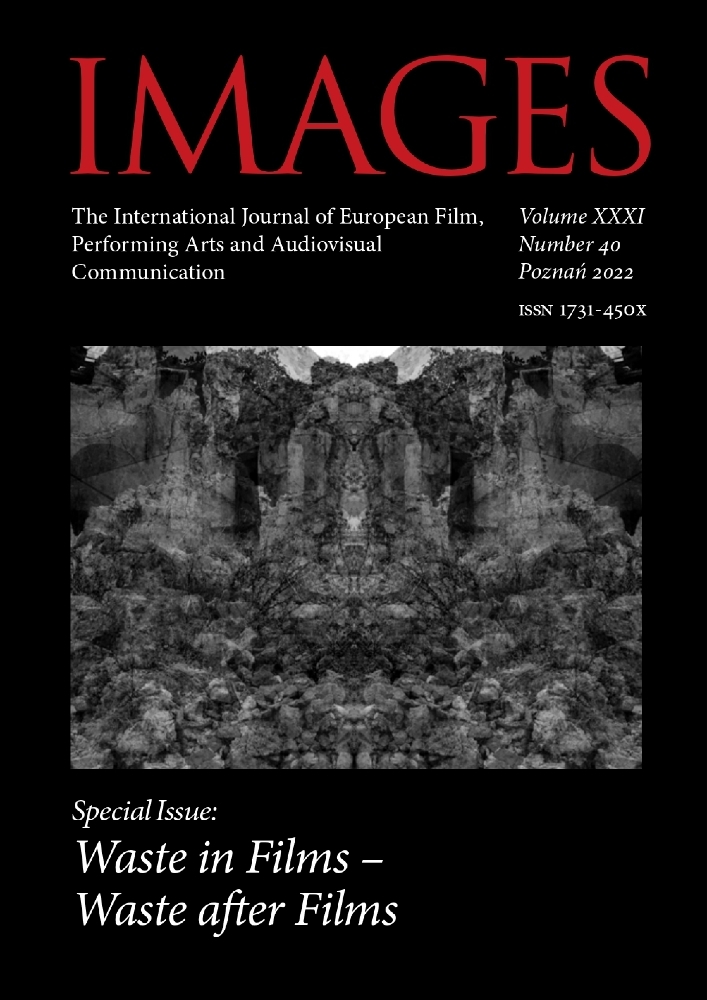Abstrakt
The article examines the ways in which the slowly evolving and invisible processes of the ongoing ecological crisis can be represented in the format of a contemporary serial television drama. The author argues that despite heavy reliance on spectacular and captivating character-born plots, the long-form storytelling of new television narratives can be well suited to representing the complex and unspectacular temporalities of the ecological crisis. With the Swedish-French Arctic noir TV series Midnight Sun as a case study, the analysis shows how a highly spectacular criminal plot is developed to reveal the invisible temporal action and nonhuman agency of a special kind of waste paradigmatic of the era of the Anthropocene, defined by Timothy Morton as a hyperobject (2013). This idea is established in Midnight Sun not only by placing radioactive waste at the center of the narrative but also by gradually foregrounding its nonhuman agency behind the events. The aim of the analysis is to demonstrate that by both using and reimagining the conventions of the television crime drama (Arctic noir), Midnight Sun translates into quotidian terms the unspectacular and long-term aspects of human-induced ecological destruction, which surpass the individual human scale and evade our cognition. An important strategy adopted in Midnight Sun is bringing together two levels of criticism: ecocritical and postcolonial. The slow ecological violence (R. Nixon, 2011) and nuclear colonialism (G. Schwab, 2020) exerted by the powerful against regions and people who are globally less visible are depicted as a continuation of the history of colonization, and more specifically, the systemic and longstanding ill-treatment of the indigenous Sámi people in Sweden.
Bibliografia
Barcz A., Przedmioty ekozagłady. Spekulatywna teoria hiperobiektów Timothy'ego Mortona i jej (możliwe) ślady w literaturze, "Teksty Drugie" 2018, vol. 2, pp. 75- 87, https://doi.org/10.18318/td.2018.2.5 DOI: https://doi.org/10.18318/td.2018.2.5
Batori A.,"Everything is connected". Narratives of temporal and spatial transgression in Dark, "VIEW. Journal of European Television History and Culture" 2021, vol. 10, no. 10, pp. 112-124, https://doi.org/10.18146/view.246 DOI: https://doi.org/10.18146/view.246
Boruszkowska I., Glinianowicz K., Grzemska A., Krupa P. (eds.), Po Czarnobylu. Miejsce katastrofy w dyskursie współczesnej humanistyki, Kraków 2017
Brylska A., Katastrofa, której (nie) zobaczysz. O wizualności nuklearnego kresu, [in:] Po Czarnobylu. Miejsce katastrofy w dyskursie współczesnej humanistyki, eds. I. Boruszkowska, K. Glinianowicz, A. Grzemska, P. Krupa, Kraków 2017, pp. 138-145
Dancus A.M., Ghosts Haunting the Norwegian House: Racialisation in Norway and "The Kautokeino Rebellion", "Framework: The Journal of Cinema and Media" 2014, vol. 55, no. 1, pp. 121-139, https://doi.org/10.13110/framework.55.1.0121 DOI: https://doi.org/10.13110/framework.55.1.0121
Hansen K.T., Waade A.M., Locating Nordic Noir: From Beck to The Bridge, Cham 2017
Harman G., Traktat o przedmiotach, transl. M. Rychter, Warszawa 2013
Harrow K.W., Trash: African Cinema from Below, Bloomington 2013
Iversen G., Norsk filmhistorie. Spillefilmen 1911-2011, Oslo 2011
Kelly J.P., Time, Technology and Narrative Form in Contemporary US Television Drama. Pause, Rewind, Record, Cham 2017 https://doi.org/10.1007/978-3-319-63118-9 DOI: https://doi.org/10.1007/978-3-319-63118-9
Komska Y., Review of HBO's Chernobyl, "American Historical Review", October 2019, pp. 1376-1378 https://doi.org/10.1093/ahr/rhz996 DOI: https://doi.org/10.1093/ahr/rhz996
Kuhn G., Liberating Sápmi. Indigenous Resistance in Europe's Far North, Oakland 2020
Mbembe A., Necropolitics, Durham - London 2019 https://doi.org/10.1215/9781478007227 DOI: https://doi.org/10.1215/9781478007227
McNeill J.R., Engelke P., The Great Acceleration. An Environmental History of the Anthropocene since 1945, Cambridge, MA - London 2014 https://doi.org/10.4159/9780674970731 DOI: https://doi.org/10.4159/9780674970731
Mecsei M.K., Cultural Stereotypes and Negotiations in Sámi Cinema, [in:] Films on Ice. Cinemas of the Arctic, eds. A. Westerstahl Stenport, S. MacKenzie, Edinburgh 2016, pp. 72-83 https://doi.org/10.1515/9780748694181-008 DOI: https://doi.org/10.1515/9780748694181-008
Mills B., Chernobyl, Charnobyl and anthropocentric narrative, "International Journal of TV Serial Narratives" 2021, vol. 7, no. 1, pp. 5-18, DOI: 10.6092/issn.2421- -454X/12419
Morton T., Dark Ecology: For a Logic of Future Coexistence, New York 2016 Morton T., Ecology Without Nature. Rethinking Environmental Aesthetics, Cambridge, MA 2007 https://doi.org/10.7312/mort17752 DOI: https://doi.org/10.7312/mort17752
Morton T., Humankind. Solidarity with Nonhuman People, London - Brooklyn, NY 2017
Morton T., Hyperobjects. Philosophy and Ecology after the End of the World, Minneapolis - London 2013
Nixon R., Slow Violence and the Environmentalism of the Poor, Cambridge, MA - London 2011 https://doi.org/10.4159/harvard.9780674061194 DOI: https://doi.org/10.4159/harvard.9780674061194
Parikka J., Anthropocene, [in:] Posthuman Glossary, eds. R. Braidotti, M. Hlavajova, London - New York 2018, pp. 51-53
Saunders R.A., Arctic Bodies. Sights/Sites of Necrocorporeality in Nordic Noir Television Series, [in:] Visual Representations of the Arctic: Imagining Shimmering Worlds in Culture, Literature and Politics, eds. M. Lehtimäki, A. Rosenholm, V. Strukov, Milton 2021, pp. 196-214 https://doi.org/10.4324/9781003158295-14 DOI: https://doi.org/10.4324/9781003158295-14
Schwab G., Radioactive Ghosts, Minneapolis 2020 https://doi.org/10.5749/j.ctv182jtjg DOI: https://doi.org/10.5749/j.ctv182jtjg
Souch I., Transformations of the Evil Forest in the Swedish TV series "Jordskott": An Ecocritical Reading, "Nordicom Review" 2020, vol. 41, no. 1, pp. 107-122, https://doi.org/10.2478/nor-2020-0011 DOI: https://doi.org/10.2478/nor-2020-0011
Tischleder B.B., Thickening seriality: A chronotopic view of world building in con- temporary television narrative, "Velvet Light Trap: A Critical Journal of Film & Television" 2017, vol. 79, pp. 120-125
Waade A.M., Arctic Noir on Screen: Midnight Sun (2016-) as a Mix of Geopolitical Criticism and Spectacular, Mythical Landscapes, [in:] Nordic Noir, Adaptation, Appropriation, eds. L. Badley, A. Nestingen, J. Seppälä, Cham 2020, pp. 37-53 https://doi.org/10.1007/978-3-030-38658-0_3 DOI: https://doi.org/10.1007/978-3-030-38658-0_3
Westertahl Stenport A., Lukas Moodysson's Show Me Love, Seattle 2012
Licencja
Prawa autorskie (c) 2023 Anna Mrozewicz

Utwór dostępny jest na licencji Creative Commons Uznanie autorstwa 4.0 Międzynarodowe.

